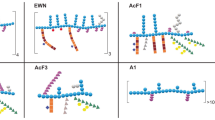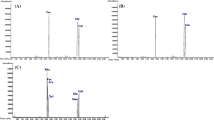Abstract
Citrus pectin (CP) and pH-modified citrus pectin (MCP) are highly branched and non-branched complex polysaccharides, respectively, rich in galactoside residues, capable of combining with the carbohydrate-binding domain of galectin-3. We reported previously that intravenous injection of B16-F1 murine melanoma cells with CP or MCP into syngeneic mice resulted in a significant increase or decrease of lung colonization, respectively (Platt D, Raz A (1992)J Natl Cancer Inst 84:438–42). Here we studied the effects of these polysaccharides on cell-cell and cell-matrix interactions mediated by carbohydrate-recognition. MCP, but not CP, inhibited B16-F1 melanoma cells adhesion to laminin and asialofetuin-induced homotypic aggregation. Both polysaccharides inhibited anchorage-independent growth of B16-F1 cells in semisolid medium, i.e. agarose. These results indicate that carbohydrate-recognition by cell surface galectin-3 may be involved in cell-extracellular matrix interaction and play a role in anchorage-independent growth as well as thein vivo embolization of tumour cells.
Similar content being viewed by others
Abbreviations
- CP:
-
natural citrus pectin
- MCP:
-
pH-modified CP
- EHS:
-
Englebreth-Holm Swarm
- CMF-PBS:
-
Ca2+-and Mg2+-free phosphate-buffered saline, pH 7.2
- HRP:
-
horseradish peroxidase
- ABTS:
-
2,2′-azino-di(3-ethylbenzthiazoline sulfonic acid
- DMEM:
-
Dulbecco's modified Eagle's minimal essential medium
- BSA:
-
bovine serum albumin
References
Sharon N, Lis H (1989)Science 246:227–34.
Barondes SH, Castronovo V, Cooper DNW, Cummings RD, Drickamer K, Feizi T, Gitt MA, Hirabayashi J, Huges C, Kasai K, Leffler H, Liu FT, Lotan R, Mercurio AM, Monsigny M, Pillai S, Poirer F, Raz A, Rigby PWJ, Rini JM, Wang JL (1994)Cell 76:597–98.
Raz A, Pazerini G, Carmi P (1989)Cancer Res 49:3489–93.
Raz A, Carmi P, Raz T, Hogan V, Mohammed A, Wolman SR (1991)Cancer Res 51:2173–78.
Jia S, Wang JL (1988)J Biol Chem 263:6009–11.
Albrandt K, Orida NK, Liu F-T (1987)Proc Natl Acad Sci USA 84:6859–63.
Cherayil BJ, Chaitovitz S, Wong C, Pillai S (1990)Proc Natl Acad Sci USA 87:7324–28.
Oda Y, Leffler H, Sakakura Y, Kasai K-I, Barondes SH (1991)Gene 99:279–83.
Woo HJ, Lotz MM, Jung JU, Mercurio AM (1991)J Biol Chem 266:18419–22.
Ochieng J, Platt D, Tait L, Hogan V, Raz T, Carmi P, Raz A (1992)Biochemistry 32:4455–60.
Ho MK, Springer TA (1982)J Immunol 128:1221–28.
Raz A, Lotan R (1987)Cancer Met Rev 6:433–52.
Lotan R, Lotan D, Raz A (1985)Cancer Res 45:4349–53.
Meromsky L, Lotan R, Raz A (1986)Cancer Res 46:5270–5.
Lotan R, Raz A (1988)J Cell Biochem 37:107–17.
Platt D, Raz A (1992)J Natl Cancer Inst 84:438–42.
Martin GK, Timple R (1987)Ann Rev Cell Biol 3:57–85.
Hynes RO (1992)Cell 69:11–25.
Sparrow CP, Leffler H, Barondes SH (1987)J Biol Chem 262:7383–90.
Merkle RK, Cummings RD (1988)J Biol Chem 263:16143–49.
Woo HJ, Shaw LM, Messier JM, Mercurio AM (1990)J Biol Chem 265:7097–99.
Ochieng J, Gerold M, Raz A (1992)Biochem Biophys Res Commun 186:1674–80.
Albersheim P, Nevins JD, English PD (1967)Carbohydrate Res 5:340–46.
Oliver MH, Harrison NK, Bishop JE, Cole PJ, Laurent GJ (1989)J Cell Sci 92:513–18.
Raz A, Meromsky L, Lotan R (1986)Cancer Res 46:3667–72.
Raz A, Bucana C, McLellan W, Fidler IJ (1980)Nature (London) 284:363–64.
Fidler IJ (1973)Eur J Cancer 9:223–27.
Kramer RH, McDonald KA, Crowley E, Ramos DM, Damsky CH (1989)Cancer Res 49:393–402.
Barondes SH (1984)Science 223:1259–64.
Stocker M, O'Neill C, Berryman S, Waxman V (1968)Int J Cancer 3:683–93.
Freedman VH, Shin S (1974)Cell 3:355–59.
Weinberg RA (1981)Biochim Biophys Acta 651:25–35.
Raz A, Zhu D, Hogan V, Shah N, Raz T, Karkash R, Pazerini G, Carmi P (1990)Int J Cancer 46:871–7.
Author information
Authors and Affiliations
Rights and permissions
About this article
Cite this article
Inohara, H., Raz, A. Effects of natural complex carbohydrate (citrus pectin) on murine melanoma cell properties related to galectin-3 functions. Glycoconjugate J 11, 527–532 (1994). https://doi.org/10.1007/BF00731303
Received:
Revised:
Issue Date:
DOI: https://doi.org/10.1007/BF00731303




